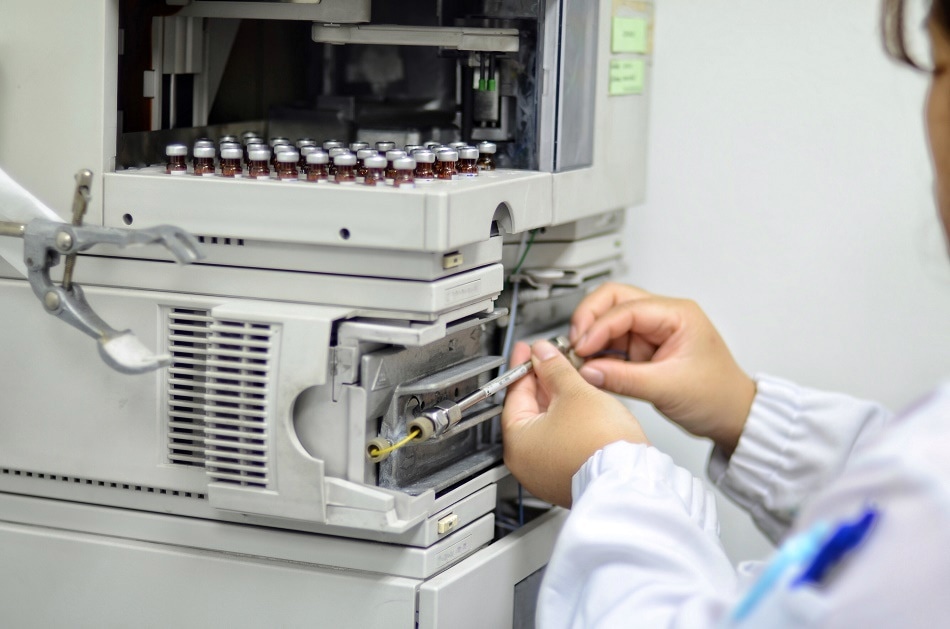
Image Credits: khawfangenvi16/shutterstock.com
High-performance liquid chromatography or high-pressure liquid chromatography (HPLC) is a chromatographic method that is used to separate a mixture of compounds in analytical chemistry and biochemistry so as to identify, quantify or purify the individual components of the mixture.
Reversed-phase HPLC or Ultra-high Performance Liquid Chromatography (UHPLC) is a commonly used separation mode. It provides dynamic retention of compounds possessing hydrophobic and organic functionality. A combination of hydrophobic and van der Waals type interactions between all the target compound and both the stationary and mobile phases enables the retention of these compounds by reversed phase.
How Does HPLC Work?
In very small amounts, the sample mixture to be separated and tested is sent into a stream of mobile phase percolating via a column. There are different types of columns available with sorbents of varying particle sizes and surfaces.
The mixture moves through the column at varying velocities and interacts with the sorbent, also known as the stationary phase. The velocity of each component in the mixture depends on 1) its chemical nature, 2) the nature of the column and 3) the composition of the mobile phase. The time at which a specific analyte emerges from the column is termed as its retention time. The retention time is measured under specific conditions and considered as the identifying characteristic of a given analyte.
Sorbent particles might be hydrophobic or polar in nature. The commonly used mobile phases include any miscible combination of water and organic solvents such as acetonitrile and methanol. Water-free mobile phases can also be used.
The aqueous component of the mobile phase might contain acids like formic, phosphoric or trifluoroacetic acid or salts to enable the separation of the sample components. The composition of the mobile phase is either maintained as a constant or as varied during the chromatographic analysis. The constant approach is effective for the separation of the sample components that are not very dissimilar in their affinity for the stationary phase. In the varied approach, the composition of the mobile phase differs from low to high eluting strength. The eluting strength of the mobile phase is reflected by analyte retention times where high eluting strength produces fast elution.
The composition of the mobile phase is chosen based on the intensity of interactions between several sample components and the stationary phase.
The HPLC partitioning process is quite similar to the liquid-liquid extraction process except that the former is a continuous process, unlike the latter which is a step-wise process. It is recommended that trial partitioning processes be performed to determine the exact HPLC method that would provide adequate separation.
Manufacturers of HPLC Systems
There is a wide range of HPLC options in the market today. The following is a list of various HPLC system producers with a brief introduction of their products:
- Dionex, a company based on the science of chromatography, manufactures the UltiMate® 3000 Rapid Separation LC system, the UltiMate 3000 RSLCnano system, and the Corona® family of universal charged aerosol detectors.
- Jasco Analytical Instruments provide a range of HPLC systems. The LC-2000 Plus Series HPLC Systems is uniquely configurable. With high performance and low cost, these HPLC systems can be adapted to virtually any requirement from simple isocratic QA to advanced multi-solvent/multi-column method development. The Isocratic LC-2000plus-Iso is provided with a pump, degasser, autosampler, and UV/Vis detector. The pump is designed with flow rates from 1µL to 10mL/min at pressures up to 500 bar for use with 2, 3, 4, 6 and up to 10mm ID columns. The Binary Gradient LC-2000plus-HPG is similar to the isocratic system but is provided with a two-solvent gradient pump configuration. The pump’s flow rates are compatible with 1mm columns. The Quaternary Gradient LC-2000plus-LPG is also similar to the isocratic system; however, this model is provided with a quaternary gradient pump configuration for maximum solvent flexibility.
- The Preparative HPLC System from Gilson has a wide flow range that can be adapted for both semi-preparative and preparative separations. Its high pumping power allows a wide range of preparative column sizes. The system is designed with a new rinse station system comprising a flowing jet wash and allows the use of up to two different rinse solvents.
- Sharp™ HPLC Systems from AAPPTec are provided with pumps that are microprocessor controlled, thus enabling highly precise and highly accurate flow rates, which can help obtain excellent analytical reproducibility and highest measurement accuracy.
Other manufacturers in the present market are Agilent, Beckman Coulter, Bio-Rad and Buck Scientific.
Benefits of HPLC
The key benefits of HPLC systems are as follows:
- Controls and automates chromatography instrumentation
- Provides data management, security features, and reporting and instrument validation.
- Powerful and adaptable
- Increases productivity by managing all the areas of analysis - from sample to instrument, and from separation to reporting results.
- Affordable
Applications of HPLC
The main purpose of the HPLC technique is to identify, quantify and purify a particular analyte or compound. Both quantitative and qualitative analysis can be done. HPLCs can be used in the following applications:
- Water purification
- Detection of impurities in pharmaceutical industries
- Pre-concentration of trace components
- Ligand-exchange chromatography
- Ion-exchange chromatography of proteins
- High-pH anion-exchange chromatography of carbohydrates and oligosaccharides
High Performance Liquid Chromatography HPLC
Sources and Further Reading
This article was updated on 22nd April, 2019.
Disclaimer: The views expressed here are those of the author expressed in their private capacity and do not necessarily represent the views of AZoM.com Limited T/A AZoNetwork the owner and operator of this website. This disclaimer forms part of the Terms and conditions of use of this website.